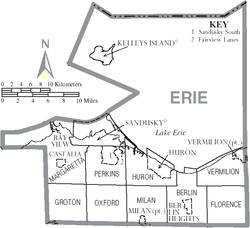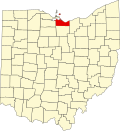2010 census
As of the 2010 United States census, there were 77,079 people, 31,860 households, and 21,011 families residing in the county. [22] The population density was 306.4 inhabitants per square mile (118.3/km2). There were 37,845 housing units at an average density of 150.4 units per square mile (58.1 units/km2). [23] The racial makeup of the county was 87.0% white, 8.6% black or African American, 0.6% Asian, 0.3% American Indian, 0.7% from other races, and 2.8% from two or more races. Those of Hispanic or Latino origin made up 3.4% of the population. [22] In terms of ancestry, 38.8% were German, 15.2% were Irish, 11.7% were English, 8.5% were Italian, and 4.6% were American. [24]
Of the 31,860 households, 29.1% had children under the age of 18 living with them, 48.5% were married couples living together, 12.9% had a female householder with no husband present, 34.1% were non-families, and 28.6% of all households were made up of individuals. The average household size was 2.37 and the average family size was 2.89. The median age was 43.4 years. [22]
The median income for a household in the county was $46,593 and the median income for a family was $61,247. Males had a median income of $46,211 versus $32,621 for females. The per capita income for the county was $25,290. About 8.5% of families and 12.5% of the population were below the poverty line, including 17.1% of those under age 18 and 8.5% of those age 65 or over. [25]
2000 census
As of the census [26] of 2000, there were 79,551 people, 31,727 households, and 21,764 families residing in the county. The population density was 312 inhabitants per square mile (120/km2). There were 35,909 housing units at an average density of 141 units per square mile (54/km2). The racial makeup of the county was 88.64% White, 8.64% Black or African American, 0.21% Native American, 0.37% Asian, 0.01% Pacific Islander, 0.53% from other races, and 1.60% from two or more races. 2.09% of the population were Hispanic or Latino of any race. 35.7% were of German, 9.2% Irish, 8.2% English, 8.1% Italian, and 7.8% American ancestry according to Census 2000.
There were 31,727 households, out of which 30.40% had children under the age of 18 living with them, 53.70% were married couples living together, 11.20% had a female householder with no husband present, and 31.40% were non-families. 27.00% of all households were made up of individuals, and 10.80% had someone living alone who was 65 years of age or older. The average household size was 2.45 and the average family size was 2.97.
In the county, the population was spread out, with 24.70% under the age of 18, 7.20% from 18 to 24, 27.00% from 25 to 44, 25.50% from 45 to 64, and 15.60% who were 65 years of age or older. The median age was 40 years. For every 100 females there were 95.00 males. For every 100 females age 18 and over, there were 92.40 males.
The median income for a household in the county was $42,746, and the median income for a family was $51,756. Males had a median income of $39,249 versus $23,697 for females. The per capita income for the county was $21,530. About 6.00% of families and 8.30% of the population were below the poverty line, including 11.60% of those under age 18 and 6.80% of those age 65 or over.
In 2008, the Census Bureau announced that the county's population had declined to an estimated 77,323 by July 1, 2007. [27]






